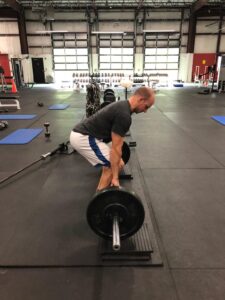
Why You Shouldn’t Look Up When You Lift
To tuck the chin or not? It’s one of the most debated topics in the world of strength and conditioning and sports medicine these days. If you’ve read any of my stuff (including the detailed presentation, “Nuances of the Neck,” in my new resource, Sturdy Shoulder Solutions), you’ll know that I prefer slightly tucking it – the so-called “packed neck position” – to preserve a more neutral cervical spine positioning, whether it’s on deadlifts, squats, or push-ups.
One of the most common arguments against this packed neck position is that Powerlifter X and Olympic Lifter Y look up during lifts, and they’re really strong. I’d encourage you to consider that:
1. Most of your clients/athletes have no interest in being Powerlifter X or Olympic Lifter Y. They just want to be fit, healthy, proficient in their sport. They value quality of life over weight room PRs – so movement quality takes place over absolute loading.
2. Good outcomes don’t necessarily equate to good movements, so it’s difficult to always draw population-wide conclusions from elite athletes. As an example, retired Cressey Sports Performance athlete Steve Cishek was an accomplished 13-year MLB pitcher, yet he had some “high maintenance” pitching mechanics that you would never teach to another up-and-coming pitcher. He just found a way to make them work, even if they did put his body in some funky positions (click through to the video; it’s a good perspective).
Just because someone is strong doesn’t mean that they’re getting to those big numbers via the most efficient or healthy avenues.
3. We have no idea what Powerlifter X or Olympic Lifter Y’s necks will look (or feel) like in their 60s.
4. Especially under load, it’s never a great idea to take one joint close to its end-range at the expense of motion at other joints. A common example is getting too much low back movement when the hips are stiff. Well, when it comes to cervical extension, most people get far too much in the upper cervical region and far too little in the lower cervical spine. So, not all “look ups” are coming from the same place – and some will certainly create more pathology than others.
5. When you go into upper cervical/head extension, you’re shortening levator scapulae, which is a downward rotator of the scapula.
If you’re looking to set up an overhead squat or snatch, it’s probably not a great idea to encourage downward rotation of the scapula when you need upward rotation for quality overhead motion. Here’s a video that delves into this a bit further:
6. You’re also shortening sternocleidomastoid, which is one of the biggest muscular contributors to chronic headaches.
So do yourself a favor and just tuck your chin a bit. And, if you’d like to learn more about the functional anatomy and unique challenges we face with the neck, be sure to check out Sturdy Shoulder Solutions.






